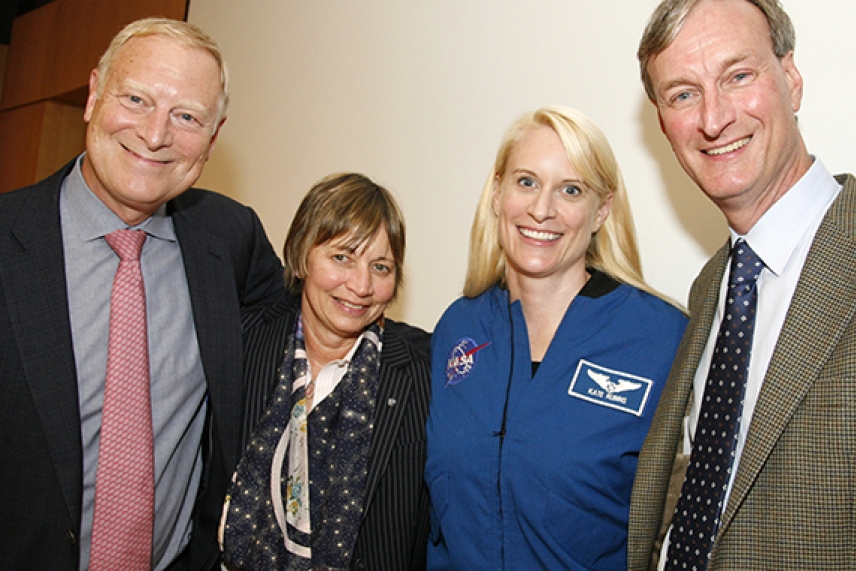Whitehead Connects: An Evening With NASA Astronaut Kathleen Rubins

(From R to L) Whitehead Institute Director and Professor of Biology at Massachusetts Institute of Technology (MIT) David Page, NASA Astronaut and former Whitehead Fellow Kathleen "Kate" Rubins, MIT Vice President for Research and E. A. Griswold Professor of Geophysics Maria Zuber, and Whitehead Member and Professor of Biology at MIT, Richard Young.
Allegra Boverman/Whitehead Institute
Whitehead Connects, an initiative of Whitehead Institute that brings notable biology and biotech leaders to the Institute for engaging presentations open to the public, was pleased to welcome NASA astronaut and former Whitehead Fellow Kathleen “Kate” Rubins on September 12, 2017.
The evening began in a packed Whitehead Auditorium with opening remarks and an introduction by Institute Director David Page. Page welcomed Maria Zuber, Vice President for Research and E. A. Griswold Professor of Geophysics in the Department of Earth, Atmospheric and Planetary Sciences at Massachusetts Institute of Technology (MIT). In her role as Vice President for Research, Zuber oversees more than a dozen of MIT’s research institutes and laboratories, as well as MIT’s Lincoln Laboratory, and is also responsible for research compliance, intellectual property, and projects with the federal government. She was the first woman to lead an MIT science department and was appointed by President Obama to the National Science Board in 2013, becoming its chair in 2016.
Zuber spoke about the current landscape of federal funding for science and the criticality of federal funds for keeping scientific discovery moving forward. She described how her own experiences with over half a dozen NASA planetary missions underscored for her how much there is to be discovered, and how work like Rubins’—at the intersection of space exploration and the life sciences—is an endeavor of utmost importance. Zuber then welcomed Rubins back to the Institute.
Rubins, a former Whitehead Fellow, spoke about her experience as a NASA astronaut and her path from Whitehead to NASA. At Whitehead, Rubins’ lab was focused on understanding the viruses causing Ebola and Marburg virus diseases, as well as Lassa fever. Her work also included special projects with the U.S. Army that aimed to develop therapies for Ebola and Lassa fever. Rubins joined NASA in 2009, and after extensive training was selected for Expeditions 48 and 49 on board the International Space Station, where she became the first person to sequence DNA in space. Rubin spent nearly four months aboard the International Space Station and logged over 12 hours of spacewalk time.
Rubins shared with the Connects audience a video detailing her mission, including the trials of living and working in microgravity, some of the more than 275 scientific experiments done by the crew, as well as her work growing heart cells in a dish, doing quantitative, real-time PCR, and microbiome experiments. The video also recounted their dramatic reentry into earth’s atmosphere, after which they landed in a remote field in Kazakhstan. The video was followed by an interactive question and answer portion moderated by Whitehead Member and Professor of Biology at MIT Richard Young. The evening concluded with a reception welcoming Rubins back to Whitehead and honoring her incredible accomplishments.
For more information about Whitehead Connects and other upcoming events, please visit this page.
Contact
Communications and Public Affairs
Phone: 617-452-4630
Email: newsroom@wi.mit.edu


